How Gopinatha got the name Ksira-cora
Category Archives: Utkal Desh
Dandabhanga
Amarda
Narasinghapur
Narasinghpur (Kanpur/Kanopur) was the preaching headquarters of Shyamananda Pandit. This village is located close to Amarda railway station on Cuttack-Howrah line, which is located in the Mayurbhanj district in the state of Odisha. From here, Srila Shyamananda Pandit preached all over North Odisha and some parts of Bengal. Syamananda flooded the people of Utkala (Odisha) with premabhakti and initated common people into the Vaisnava faith. Apart from Narasinghapur, places such as Dharenda, Gopivallabhapura, Balaramapura, which were formely in Orissa but are now in the
district of Midnapura, West Bengal.These were the main preaching centers of premabhakti by Syamananda and his disciple Rasikananda.
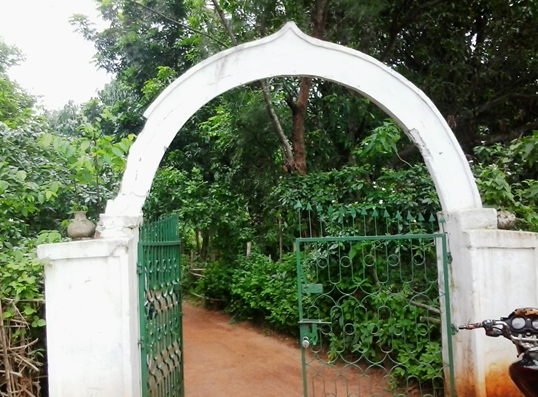
Shymanand Pandit Samadhi:
One day, while in Narasinghapur, Shyamananda received a solemn report that his spiritual master Srila Hridoy Chaitanya had passed away in Kalna. At that moment, all of his achievements felt hollow, like empty shells, for he had pursued them merely to please his guru. He could not tolerate the sad news, and he called for his disciples to comfort him and to discuss the glories of Hridoy Chaitanya andheld a festival in his honor.Gradually Shyamananda was able to go on with his preaching activities.
Sooner word arrived that Shyamananda’s dear disciple, Damodar, had also departed this world. It is said that Shyamananda never recovered from this shock and from that day he wasin severe illness. In his illness, he stayed at the royal home of Uddanda Roy in Narasinghapur. All medical aid was administered but to no avail. Still, he received many visitors and until his last breath he vigorously preached the conclusions of Vaishnava philosophy.
He openly appointed Rasik his spiritual successor and asked all of his followers to submit to Rasik’s demands. “Those who disobey Rasik,” he said, “shall be regarded as hostile to me.” He asked Rasik to watch after his wives as well, and to increase the preaching mission. Thus in 1630,he passed away. Rasik constructed a beautiful tomb (samadhi) in Narasinghapur.Rasik conducted an elaborate ceremony in honor of his departed guru. Thousands of Vaishnava and Muslim chiefs, zamindars, kings, queens, and others attended to pay their last tribute to the exalted devotee who was responsible for the transformation of entire Orissa.
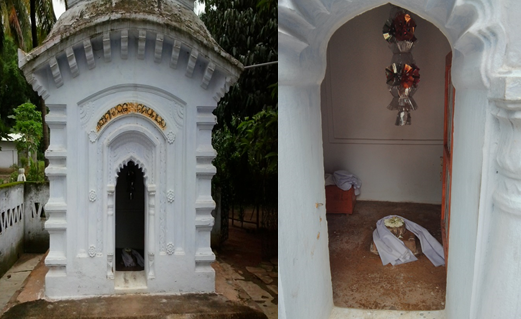
Rasik continued to spread the movement after his guru’s demise. He also managed to resolve a severe difference of opinion among Shyamananda’s widows, a difference that threatened to splinter the movement. Rasik established twelve important days of celebration for all followers of Shyamananda Vaishnavism.
The following festivals are still observed till today:
(1) The anniversary of the passing of Shyamananda;
(2) Hera Panchami;
(3) Ratha-yatra;
(4) The nativity of Mahaprabhu;
(5) The anniversary of the passing of GauridasPandit;
(6) The nativity of Shri Krishna;
(7) The nativity of ShriRadha;
(8) The UtthanaEkadashi ceremony;
(9) Rasotsava;
(10) Dolyatra;
(11) Kojagari Lakshmi-utsav; and
(12) Theanniversary of the passing of Hridoy Chaitanya.
Other Pastimes at Narasinghpur– On the order of Srila Jiva Gosvami, Syamananda Prabhu travelled from Vrindavan to Orissa to preach the message of Mahaprabhu. As he was coming into the Mayurbhanj area of northeastern Orissa, Syamananda spoke to his intimate disciple Rasikananda about a demoniac zamindar named Uddanda Ray who ruled like a small king in an area on their path. Syamananda told Rasika, “Uddanda Ray hates the vaishnavas. He has killed and robbed many saintly persons who came through his village. If a wicked person such as he can be changed then it will be marvellous. Let us both go to his place.”
They arrived at Narasinghpur in the evening. Uddanda Ray was lying on his bed but not sleeping. Suddenly he saw someone enter his room and stood before him. In a grave voice, that mysterious person told the king, “Dedicate yourself to Syamananda Ray,” and disappeared. Uddanda Ray considered the voice to be divine and began to think about when he would meet this person Syamananda. Just at that moment, Syamananda and Rasika entered the home of Uddanda Ray. Seeing Syamananda standing before him, Uddanda Ray fell at his feet and worshiped him in various ways. It is said that just by the power of SyamanandaPrabhu’spresence,Uddanda Ray became a changed man. He took shelter of the lotus feet of Syamananda, who then blessed Uddanda with devotion to the Lord. Everyone was astonished to see the king whowas transformed from a demonoic mentality to a statewhere he knows nothing but service to guru, Krishna, and the devotees.
Uddanda Ray confessed to Syamananda, “There is no limit to the terrible sins I have committed. I have killed thousands of vaishnava sadhus. After killing them I collected their asanas (cloths used by sadhus to sit on during their bhajana). Uddanda then produced seven hundred and eighteen asanas that he had collected from the devotees he had killed. They were the size of a small hill. The repentant zamindar king then showed them a well that for years he had used to dispose of the dead bodies of the devotees he had killed. Syamananda distributed those asanas to the vaishnavas, and the king also offered clothes and various other items to the devotees. Everyone in the local area was astonished to see thedemoniac king had become a gentle devotee.
From that day on, Uddanda Ray began to serve all the vaishnavas with great humility and love. Later, Syamananda brought his deities, Syama Ray, from his birth place Dharendra. With the assistance of Uddanda Ray, kept the Deities in huge festivals in Narasinghpur. Syamananda later installed Radha Krishna deities there and named Sri Sri Radha Mohanji. In the year 1630 AD, Syamananda spent four months at Uddanda Ray’s house and then left his body there.
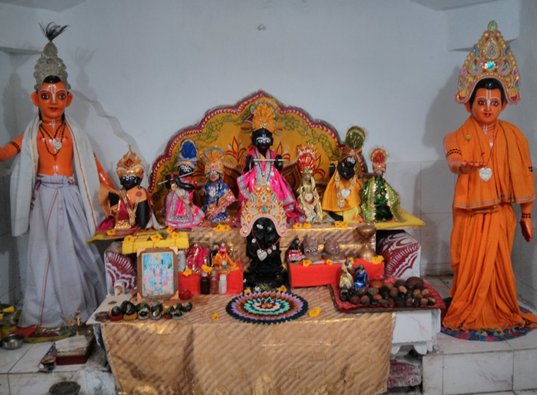
Syamananda Prabhu’sbhajana-kutir and full samadhi are still present in the remote village of Narasinghpur in Orissa’s Mayurbhanj district. Syamananda had dug two tanks them and installed as Radha kund and Shyam kund.
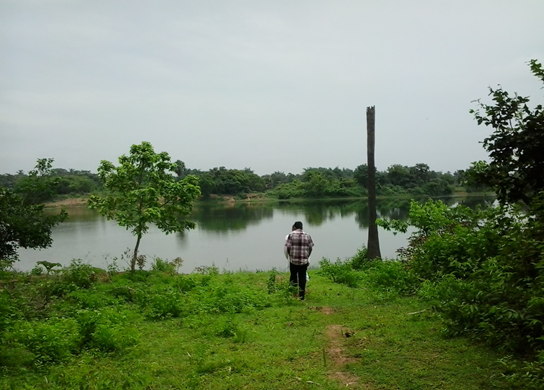
The worship of Sri Sri Radha Mohanjiu was later passed on to one of Syamananda’s disciples, who became the mahant, temple manager. The local devotees tell an interesting story. The deity was maintained by some agricultural fields that the temple owned. No one was there to help with the farming, so the mahant was working in the fields and also taking care of the deities. At one point he became very sick. Another devotee was brought in to worship the deities, but there was no one to tend to the fields. It was the time to plough the land, but no one was available. Understanding the situation, the mahant cried and prayed to Krishna, “My Lord! What can I do? If the fields are not ploughed now, then the planting will not be done. Then there will be no crops, so how will we take care of You?”
The next morning when the pujari came to wake the deity, he was surprised to find that Krishna’s flute was gone. He also couldn’t understand why there was mud on the deity’s hands and feet. Then,a villager came and congratulated the pujari for ploughing the field so nicely the night before. “What are you saying?” the pujari asked, “I didn’t plow the field last night.” The villager looked at him strangely, and said, “Well, come see for yourself!” When the pujari went to look, he was astonished to find that someone had nicely ploughed the field last night. Noticing something shiny on the ground, he bent down to pick it up and found Krishna’s flute.
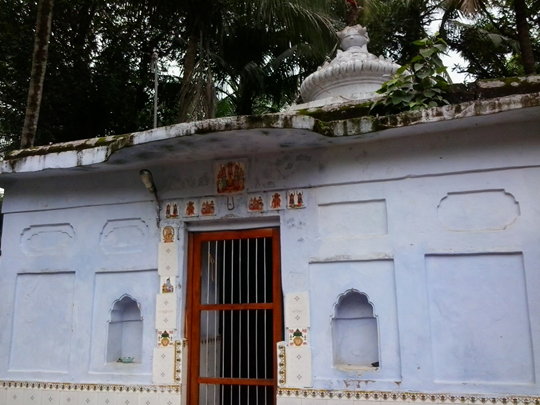
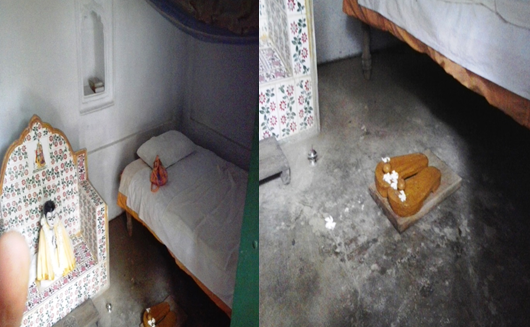
Bhajan kutir is next to samadhi of Shyamanand Pandit. A beautiful deity of Shyamanand Pandit and a nice life size bed occupies the Bhajan Kutir. Devotees serving there mention that Shyamanand Pandit’s presence can be still felt here today. One striking point is that the wooden slippers kept in the Bhajan Kutir has to be changed every year as it soles gets worn out indicating that Shyamananda Pandit uses them . On the disappearance day of Shyamanand Pandit, new wooden slippers are replaced.
Uddanda Ray’s samadhi is also in the same compound. After becoming a devotee, he felt humbled that he lamented many timesfor his past deeds of troubling people. So he begged from his guru Shyamanand Pandit that when he leaves his body his samadhi should become steps to the holy Radhakunda created by Shyamanand Pandit in the area. Thus eternally he will receive foot dust of all visitors to Radhakund thus he will feel that he is forgiven by all. Even today you can see the remains of these steps which is the samadhi of Uddanda Ray.
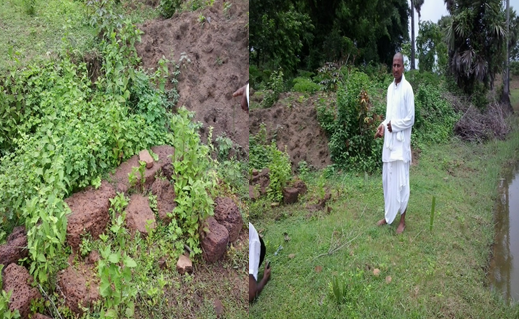
Shyamananda Pandit’s preaching in North Odisha (excerpts from Lives of Vaishnavasaints by Satyaraj das)
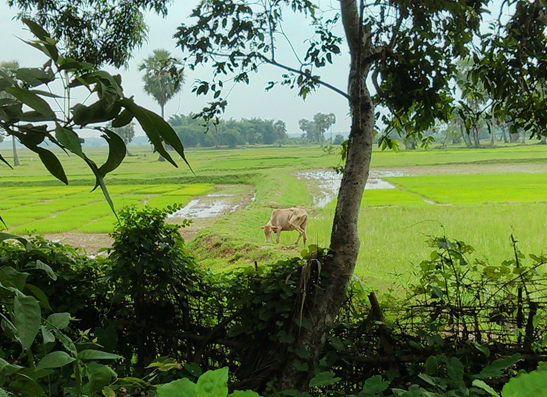
Prema-vilas relates an interesting episode that occurred just after Shyamananda’s return to Orissa. During this period, he began the nagara-sankirtan festival, leading his followers through the streets in ecstatic chanting and dancing. One day, Sher Khan, a militant Pathan who is an important representative of the Muslim court, attacked Shyamananda’s kirtan party. The very sight of “blissful Hindus” infuriated him beyond words. He broke into the middle of the party and stopped it, threatening the devotees and insisting that they never do it again.
Not heeding the words of the notorious Pathan, Shyamananda returned to the streets the very next day with an even larger kirtan party. Naturally, this vexed the Muslim soldier, who gathered his colleagues and again disrupted the kirtan. This time, however, the Muslim soldiers were violent, breakingmridangas and throwing kartals into the river. At that point, Shyamananda began to shout in a high-pitched mystical way, calling upon the names of Radha and Krishna. When Sher Khan and his cohorts heard this sound, they began to cough blood and found that their beards and mustaches had caught fire. Shocked at Shyamananda’s potency, everyone left that place in a stupor.
The next day, Shyamananda again led his sankirtan party, and when Sher Khan saw the devotees approaching, he fell at Shyamananda’s feet, begging for mercy. He said to Shyamananda: “My Lord, in addition to coughing blood and the scorching of my facial hairs, I had a terrible nightmare. The Supreme Lord, Allah, appeared to me and slapping my face repeatedly says that He is the same as your AhladaSwarup, or the form of God that is revealed to the Vaishnavas. He shows me His golden complexion and says that in His most confidential feature, He is none other than Shri Chaitanya Mahaprabhu. He further says that you are His favorite devotee and that I should be initiated into the chanting of the holy name by you alone.” Shyamananda was moved by the Pathan’s conversion and duly initiated him into the Gaudiya tradition. Sher Khan received the name “Chaitanya Das” after his initiation.
Shyamananda soon opened a second temple at Narasinghapur. Many hard working devotees helped him with this project by engaging in missionary activity, temple construction, worship and fund-raising. This secured him an even larger following in northern Orissa.